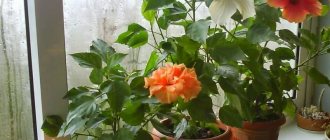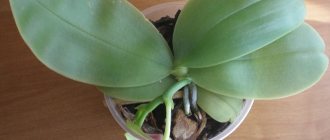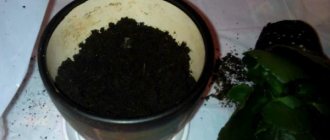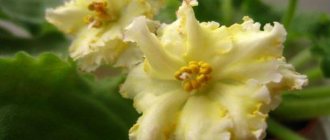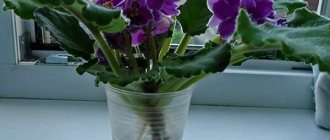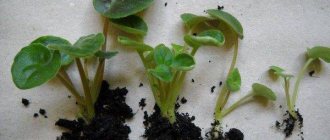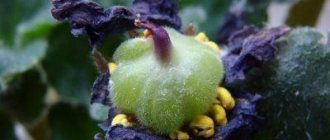Violet Uzambara, or Saintpaulia, perhaps the most common inhabitant of window sills in many apartments.
Flower growers love it for the soft, velvety shape of its leaves and even more for its beautiful flowers, which come in different colors depending on the variety.
The violet will successfully fit into any interior and will delight the eye with its flowering for 9 months a year.
Unfortunately, there are times when flowers appear in small quantities or completely absent. The reasons for this may include errors in care, the presence of parasites and violet diseases.
Violet - description, photo
Uzambara violet is a common house flower. The small bush has a lush hat of different colors. The buds consist of five petals, collected in brushes. The colors are white, lilac, and red. Violets begin to bloom at one year of age, in the spring, when they begin to receive enough natural light.
indoor violet during flowering period
They bloom almost all year round, the frequency depends on the variety. The non-flowering period takes 2 months annually. When the Uzambara violet does not bloom for a long time, this indicates improper care. Violets are capricious indoor flowers, sensitive to external factors. Housewives love to grow them on windowsills; a bright, lush head of flowers fills the house with coziness.
Sometimes flowers, when healthy, do not bloom for a long time. The flower blooms rarely, until the flowering ability is completely canceled. Why could this be? It turns out that this depends on many factors. Only by analyzing the true reasons can you force the buds to bloom again.
Fertilizers to stimulate flowering
If it is possible to provide additional lighting in the fall and winter, and the buds continue to form, fertilize the violets evenly all year round:
- with manual irrigation - every 2 weeks;
- if Saintpaulia is “planted” on a wick, add preparations to the water for irrigation.
When, at the end of the season, a violet without lighting stops producing buds due to a short day, the intensity of fertilizing is halved. Reduce the concentration of the drug during wick watering.
High doses or frequent fertilizers do not stimulate, but rather prevent the violet from blooming. After transplanting into a store-bought substrate, the plant is not fed for 1-2 months.
Mineral
Use specialized complex fertilizers “Saintpaulia” or “Violet”. The following brands have performed well:
- Agronomist Pro;
- Blank sheet;
- Proventus;
- Master;
- NPK standard;
- Royal Mix;
- Fertika;
- Power of Life.
Fertilizers for ornamental flowering crops can be used, but you need to dilute them 2 times more than the instructions recommend.
Organic
Violets cannot tolerate mullein infusion or bird droppings. Organic preparations made from peat or humates must be purchased in the store. It is better to take specialized ones, with the inscription on the packaging “Saintpaulia” or “Violet”. They are produced under the following brands:
- Stimovit;
- Ultra Effect;
- Reasil;
- Stimulus.
Reasons why indoor violets do not bloom
Saintpaulias are heat-loving and require special care. For flowering, much attention should be paid to room lighting. With constantly poor daylight, the flowers begin to wither. Flowering becomes delayed, even completely absent. What other reasons are there why homemade Saintpaulias stop blooming?
Incorrect lighting
A common reason for violets to stop blooming. Lighting duration is required at least 12 hours. Natural or artificial lighting is suitable. Excessive light promotes healthy growth. Having good lighting is especially important from the very beginning of flowering. Lack of light is characterized by upward growth and stretching of stems. Normal condition - leaves lie around the pot. Excessive lighting contributes to fading and drying of leaves and buds.
the result of improper lighting of the violet
Lack of fertilizing
The plant needs to be fed regularly with the right preparations. It is recommended that flowers be provided with mandatory weekly feeding. Improper feeding is a common reason why Saintpaulias stop blooming. The main rule is not to overdo it with fertilizing nitrogen-containing preparations. Excessive feeding negatively affects lush flowering.
Incorrectly selected soil for planting in a pot
If you use ordinary soil from the garden for growing, problems with the health of violets will soon begin. The composition of the soil and the level of acidity greatly affect flowering. Watering washes away nutrients, turning them into clay. Hard, compacted soil makes it difficult for the root system to grow. The roots do not receive enough minerals - all parts of the plant suffer.
In addition to fertilizing the soil, they supply the soil with oxygen and make it loose. The soil must be breathable. You can purchase a special soil mixture and make it yourself. Wood ash, spruce sawdust, crushed moss, crushed bark, and peat are mixed with the soil.
Important! The amount of peat you need to take is less than the other ingredients. By promoting the growth of leaves, it will prevent the blossoming of buds.
Frequent temperature changes
A sharp change in temperature leads to the fall of the buds, stopping the flowering ability. It is recommended to keep the room temperature at medium temperature, neither low nor high. Recommended temperature is around 20 degrees. It is necessary to avoid sudden changes in heat and cold.
Under or over watering
The fading of a flowering species may be due to improper watering. The quality of irrigation water is important. Watering with hard, dirty, cold water is unacceptable. Tap water is left to settle overnight before watering. It is important not to overdo it with watering, otherwise the nutrients will quickly leave the soil with water. Due to lack of watering, the soil dries out, cracks, the leaves dry out locally, as if they were burnt by the sun.
violets only grow leaves
Diseases and pests
Saintpaulias are tender and sensitive to diseases and pests. If problems affect violets, the plant will have a hard time withstanding such trials. The main pests that harm Saintpaulias at home:
- nematodes - destroy the roots, the leaves become covered with white-green dots;
- aphids - eating the succulent part, kills the plant;
- mealyworms - suck out the juices, lay larvae on the back of the leaves;
- thrips - they eat leaves, which then darken and dry out completely, and can fly to other indoor plants in the room.
Diseases and pests can appear in winter and summer. You will have to completely change the soil to completely get rid of the problem. The reasons for the lack of flowers in violets are described in the video.
Genetic feature of the variety
Some varieties, due to their individual characteristics, have a small number of buds. Even ideal care, observing all the basic rules, deprives the plant of the opportunity to bloom. Depends on the characteristics of the variety, genetic predisposition. There are varieties that bloom once a year. Rarely bloom with a beautiful flowering lush cap. Healthy flowering does not affect frequent blooming, it depends on genetics, variety, species.
Important! You can get profusely blooming violets by understanding the varieties.
Thickened state in one pot
By planting several plants in one pot, rapid active growth will begin. The plants will quickly suck out the nutrients, and the condition will begin to deteriorate. To avoid an unfavorable situation, separating the stems and transplanting the sprout into a separate small pot will help.
lack of violet flowering - increased leaf density
Too big container for growing
After planting, Saintpaulias devote their remaining energy to the development of the root system. A larger pot requires more time for the roots to grow. A small container is needed to grow a flower.
Important! Pots with few holes interfere with healthy growth and flowering.
No transfers
If the violet has never been replanted into another soil, the poor condition of the violet is almost impossible to avoid. Any plant, even with regular feeding, must be replanted in a pot with new soil. It is recommended to carry out transplantation regularly after 7 months. Exceptional cases require immediate transplantation upon visual inspection. The flower became cramped in the pot.
Having reached the age of three, Saintpaulia stops blooming for natural reasons. They save the situation by cutting off the green parts of the plant. The process is called rejuvenation.
Diseases
The main enemies of violets are powdery mildew, late blight, aphids and gray rot . If the plant becomes covered with spots, a gray coating appears on it, Saintpaulia becomes ill and simply does not have the strength to form inflorescences. As soon as the first signs of the disease are noticed, measures must be taken immediately, since from one plant the disease can spread to the entire collection. You can read more about diseases and pests of violets in this article.
What to do if violets do not bloom after transplanting
Caring for Saintpaulias at home is required based on the identified main reasons for the lack of flowering. Care rules must be followed after transplanting indoor Saintpaulias. It is easier to preserve young ones than to force older ones to bloom.
Pay attention and monitor the frequency of watering
The condition of the soil changes with excessive watering. It becomes dense, similar in consistency to clay. As they dry out, cracks appear on top and the leaves begin to darken. With a lack of watering, the soil dries out in clumps, the buds fall off, and the edges of the leaves dry out. The initial stage begins with the removal of diseased leaves. The soil is always left slightly moist, but soft. Water from below, directly into the soil at the base of the stems. Use water at room temperature, soft.
violet does not bloom at home
It is necessary to create additional air humidity near the plant
In winter, air humidity in a heated room is about 20-30%, violets require 50%. You need to hang wet towels over the radiators and place a couple of shallow plates with water nearby.
Attention! If parasites have managed to damage one of the pots with homemade violets, it is recommended to throw out the plant immediately.
Proper care
Violet is a moisture-loving plant. In nature, it can be found near ponds and streams. The conditions of a dry home climate are less easily tolerated by the crop. The plant needs to create conditions close to natural.
The necessary techniques to guarantee healthy growth were discussed above: choosing a location, creating an optimal air humidity of 50%, proper watering, spraying, lighting, preventing the appearance of pests and diseases, fertilizing, maintaining the required temperature. Only if you have all the necessary measures you can achieve what you want.
If it grows upward and does not bloom
The blooming species depends on many factors, including the variety. A plant that does not bloom for more than six months is in most cases due to improper care. Why doesn't indoor violet bloom? It is necessary to take action in time, otherwise it will be too late to save.
In addition to the lack of buds blooming, if timely measures are not taken, the color of the Saintpaulia leaves will change. They begin to turn brown, turn yellow and then dry out. The following steps will help you get rid of the factors that interfere with the flowering of Saintpaulia:
- For pests, stores sell special preparations for spraying and pollinating the soil. A weak solution of manganese when sprayed gets rid of gray rot. If aphids, mites and mealyworms harm the flowers, first wash the top part with soapy water. In case of advanced situations, spray with phytoverm.
- If flowering has stopped in cold weather, the senoplia most likely needs to be insulated. Place the pot on top of an object with poor cold conductivity. The most easily accessible option is polystyrene foam. Be sure to avoid drafts and sudden temperature changes. Important! At night, Saintpaulias need coolness, during the day - moderate light, warmth - 20 degrees.
- If violets grow upward and do not bloom for a long time, the required lighting is not available. The daily requirement of light for Saintpaulias is 12 hours. On cloudy days, with the onset of autumn, sunny days decrease. During this period, artificial lighting lamps are used.
- The next stage of pulling the leaves up is to curl them. In an advanced situation, it is difficult to save old foliage. Don't worry if it starts to fall off. Subsequent proper care will contribute to the appearance of new young leaves that will grow properly.
the leaves of the homemade violet are curling
When does flowering occur after planting?
If we are talking about adult bushes transplanted into another pot:
- transshipment does not require removal of buds;
- When the earthen clod is destroyed, the flower stalks are torn off; it takes from 2 to 5 weeks for new ones to form in the axils of the leaves, plus time for the full formation and opening of the corollas.
A violet grown from a baby will bloom in 8-10 months. There are varieties that produce buds after six months or “sit in place” twice as long.
The first flower stalks need to be removed, leaving one to check whether the violet has sprung. And after opening the corolla, immediately tear it off so as not to weaken the bush.
Some Saintpaulias manage to acquire buds when the daughter rosettes are not yet separated from the mother leaf or immediately after transplanting into individual cups. The flower stalks on them need to be removed; if this is not done, in the future the bushes will bloom poorly and the violets will grow weak.
On planted stepsons, buds appear when rosettes of the same variety grown from leaves, minus 1.5-3 months spent on rooting and germination. When the violet rejuvenates, the top produces buds as soon as the sucking shoots entwine the clump.
It will take about a year and a half for Saintpaulias to start blooming from seeds.
There are many leaves, but the violet does not bloom
There are times when the plant looks visually healthy. The foliage is lush and bright green, but the violet bush does not bloom. What is recommended to do to make the buds bloom?
Reasons: 1. Large amounts of nitrogen can accumulate in the soil. It is necessary to reduce the frequency of nitrogen fertilizing. 2. The bush in one pot has thickened. A transplant with division of the uterine bush is necessary. Each stem is transplanted into a separate pot.
Solution to the problem: 1. Transplant into new soil. 2. To prevent further loss of buds, it is necessary to fertilize the soil with a special preparation with a high phosphorus content. The soil should be loose; for this it is recommended to mix it with spruce sawdust, peat and crushed moss. 3. It is recommended to choose small pots, otherwise all the energy will be spent on growing the root system.
Important! It should be replanted in the spring, during the natural beginning of flowering season.
Pests are bothering the plant
The presence of parasites is also not an incentive to continue flowering.
The main ones are aphids and mites, whose vital activity is manifested in the formation of cobwebs on the flower organs, and scale insects.
If they are present, red spots appear on the leaves. In the initial stage, washing with a weak soap solution helps.
The most dangerous pest for violets is nematodes. These organisms live in the root system and damage it over time, making it impossible for further nutrients to reach the flower. The violet dies.
To prevent the appearance of nematodes, it is recommended to bake the substrate in which the violet will grow well in the oven.
How to make it bloom at home
With proper care you can achieve flowering of Saintpaulia. The measures taken are followed, the plant looks healthy, but the formation of buds stops. It is advised to give a small shock shake in order to start the blossoming process. Gardeners sometimes resort to unconventional ways to save the situation:
- Cut off all the leaves, leaving 5-6 pieces. To dry the sections, leave them in a sunny place, then put them away in a dark place for a month. During this period, water the flower once. After the required period has passed, the pot is returned to its original place. In a month, the renewed Saintpaulia will begin to bloom.
- Using brewed black tea instead of fertilizing. This method keeps the soil loose for a long time. Advice! Black tea attracts midges, you should change the feeding more often.
- Citrus infusion for root feeding. Fresh or dried citrus zest is poured with hot water and left for two days. Fertilize once a month. Fill the tray with infusion and place the pot on top. Leave for half an hour, remove the pot on top of the expanded clay to remove unnecessary moisture.
- Outside root feeding from pharmaceutical glucose. One tablet is dissolved in a liter of water kept to room temperature. Spray the above-ground part with the solution once every two weeks.
- A tablespoon of sugar sprinkled on top of the soil before watering will cause the violet to open its buds after several treatments.
- Fertilizing with yeast is an effective means of promoting the blossoming of Saintpaulia. Its nutritional capacity can be compared with mineral fertilizers. A pinch of yeast and sugar is dissolved in a liter of warm water. Water the plant with the solution.
- It is recommended to carry out foliar feeding on cloudy days so that the plant avoids burns and rotting. In winter, when the violet is resting, fertilizing is reduced. Carry out only when necessary.
Requirements for conditions of detention
The ecological features of the growth of this type of plant in the natural environment are taken into account when growing indoors and in greenhouses. Saintpaulia's natural habitat is the mountainous areas of Tanzania and Kenya (East Africa), where it can be found near waterfalls and along river banks. This means that she loves warmth, humidity and light, rather diffused, since due to her small size she is a resident of the first tier.
The flower owes its name to Baron Walter von Saint-Paul, commandant of the Uzambara district, who discovered it in 1892
Lighting
Western, eastern and northern windows are more suitable for growing violets. On southern window sills they will have to be shaded. For normal growth, development, and flowering, Saintpaulias need 12 hours of daylight. This is important to consider when using artificial lighting. With a lack of light, the plants will stretch out and stop blooming.
Temperature
African beauties do well in a temperature range of 20 to 24 ℃, but can withstand slight deviations both downwards and upwards. It has been proven that with a cooler content ( 18…20 ℃ ), the color of the petals and greenery will be brighter .
In variegated varieties, edging and spotting appear more clearly in cool conditions.
Humidity
Saintpaulias love humidity, but they suffer if water gets on the leaves or rosette. To create the desired microclimate, use air humidifiers or place pots on a tray with a layer of sphagnum or gravel. It’s good when it is possible to use sphagnum. Natural moss creates an ideal environment: it absorbs excess moisture flowing from the drainage holes and evaporates it, humidifying the air.
Water the flower in a tray or along the edge of the pot (preferably from a watering can with a long spout); specialists sometimes use wick irrigation. The frequency of watering is adjusted so that the top layer of soil has time to dry out between them. The remaining water flowing into the pan of the pot must be drained, otherwise the roots may rot. Water with settled, lukewarm water, as cold water can lead to yellowing of the leaves and rotting of the root system.
If it is not possible to regularly care for flowers, for example during vacation, it is convenient to use automatic drip systems
The main rule for watering violets is to observe the measure: do not overwater or overdry. It’s better not to top up than to moisturize abundantly and often!
Signs - why the violet does not bloom
Indoor Saintpaulias fill the atmosphere of the home with comfort. It is believed that violets in the apartment have magical powers and can change fate. There are popular beliefs about the influence on the lifestyle of household members. Most often, the nature of the energy influence on fate depends on the color of the bud. However, there are several bad omens associated with violets. Most signs about unblown Saintpaulias are negative. If violet:
- was bought from an unknown woman, does not bloom, it promises a dark streak in life;
- does not bloom on an unmarried woman - she will remain unmarried;
- with red buds that have stopped blooming - someone in the house will die;
- They do not bloom for a long time, at night they suck energy from their owners, like vampires.
- does not bloom with white buds, then there will be discord in the family, bad thoughts will consume the mind;
- does not bloom with purple buds - it will bring stress and nervous conditions to the owners;
- placed with a pot near the child’s bed and does not bloom, it will lower the immune system and make him more susceptible to disease.
Whether to believe in omens is up to everyone. However, the negative “vampire” influences of violets have been proven by scientists. The violet releases oxygen only during the day and releases carbon dioxide at night. This causes morning headaches, dizziness, weakness, and general poor condition of the body. It is better to listen to scientists and avoid placing a potty in the bedroom.


